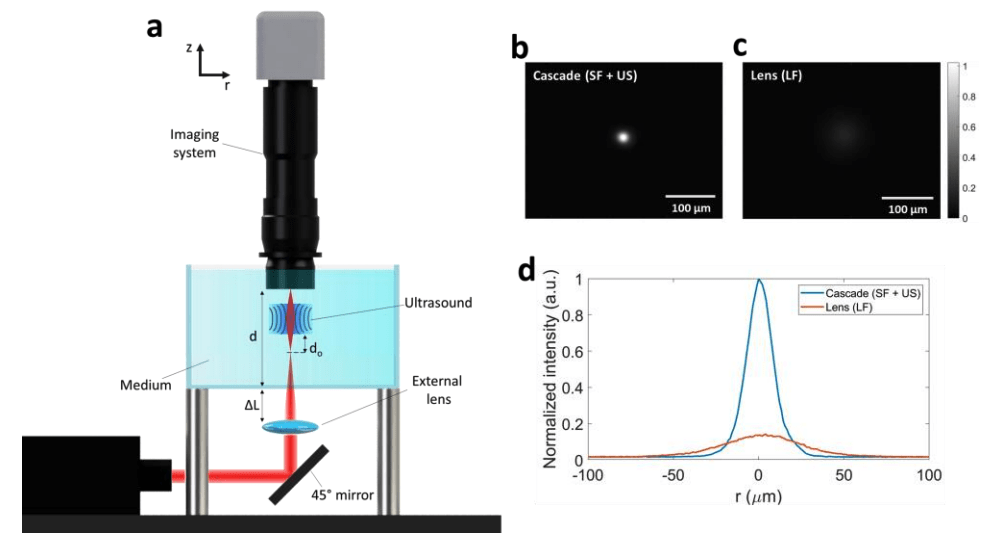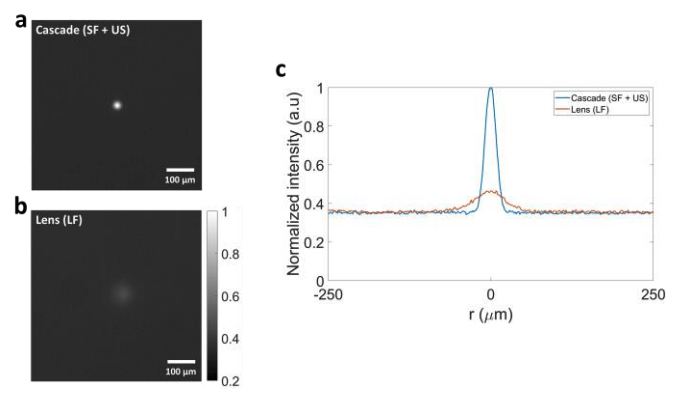Virtual ultrasonic optical waveguides
a tradeoff between depth of penetration and spatial resolution
Conventional optical lenses have been used to focus light from outside without disturbing the medium. The focused spot size is proportional to the focal distance in a conventional lens, resulting in a tradeoff between depth of penetration in the target medium and spatial resolution. We have shown that virtual ultrasonically sculpted gradient-index (GRIN) optical waveguides can be formed in the target medium to guide and steer light without disturbing the medium.

a) Optical ray tracing simulation results showing the axial beam paths through the medium and the spot size at the focal plane of a long focal distance lens. b) The radial cross-section of the focused beam of light at point P. The diameter of the focal spot is FWHM= 12.05 μm. c) The axial beam paths through the medium and the spot size at the focal plane of the cascade optical system of an external lens and the virtual GRIN waveguide. d) The radial cross-section of the focused beam of light at point P using the cascade system. The diameter of the focal spot is FWHM= 3.76 μm. In these simulations, the medium is assumed to be water, d = 47.22 mm, ΔL = 11.27 mm, and do = 13.47 mm. The scale bar is 10 μm.
Virtual Waveguides
More Info
We have recently shown that ultrasound waves can be used to guide and pattern the trajectory of light by locally changing the refractive index of the medium. Using this technique, we have demonstrated the possibility of forming in situ virtual gradient index (GRIN) waveguides, virtual relay lenses, and spatial light modulators non-invasively
Configurable Ultrasound Pattern
More Info
We have shown that these virtual optical components can be formed in transparent as well as scattering media such as biological tissue. In this method, the virtual optical component can be reconfigured by simply changing the pattern of ultrasound waves from outside the medium. A nonlinear photoacoustic wave implementation of this idea has also been recently demonstrated for light guiding to deep biological tissue sites.
High Resolution
More Info
Our simulation results suggest that by sculpting the appropriate refractive index pattern within the target transparent medium, light focused by an external lens can be relayed through multiple pitch lengths of a virtual GRIN waveguide while maintaining or even decreasing the focal spot size. Therefore, using this cascade system of an external physical lens and the virtual GRIN waveguide, the tradeoff between the focal distance and the focal spot size of the external lens can be overcome.
Overcoming the tradeoff using virtual ultrasonic optical waveguides
Here, we demonstrate that such virtual waveguides can relay an externally focused beam of light through the medium beyond the focal distance of an external physical lens to extend the penetration depth without compromising the spot size. Moreover, the spot size can be tuned by reconfiguring the virtual waveguide. We show that these virtual GRIN waveguides can be formed in transparent as well as turbid media to enhance the confinement and contrast ratio of the focused beam of light at the target location. This method can be extended to realize complex optical systems of external physical lenses and in situ virtual waveguides to extend the reach and flexibility of optical methods.

a) The schematic of the experimental setup showing the cascade system, where a short focal distance (SF) external lens is used to confine light through the medium, and a virtual ultrasonically defined GRIN waveguide is used to non-invasively relay the focused beam of light to a depth d into the medium. The distance between the external lens and the medium is ΔL, and the distance between the focus of the focal plane of the external lens and the virtual GRIN waveguide is do. b) The confined beam of light at the depth d = 47.1 mm into the medium (DI water) using an aspheric lens with an effective focal distance f = 25 mm (in air) and the virtual GRIN waveguide formed at do = 13.47 mm. c) The confined beam of light at the depth d = 47.1 mm into the medium (DI water) using a single aspheric lens with a longer effective focal distance (LF) f = 50 mm. d) Radial cross-sections of the beams for the single external lens and the cascade system. The FWHM of the spot size for a single external lens is 49.4 µm, while for the cascade system it is reduced to FWHM=17.6 µm. The acquisition parameters were kept the same for both cases.

a) The confined beam profile of light at the optical depth of 4.38 TMFP into the scattering medium using a cascade system of an aspheric lens with a short focal distance (SF) f = 25 mm (measured in air) and the virtual GRIN waveguide formed at do = 13.47 mm. b) The confined beam of light using a single aspheric lens with a longer focal distance (LF) f = 50 mm (measured in air). c) Radial cross-sections of the beams for the single external lens and the cascade system.

a) The confined beam profile of light at the optical depth of 4.95 TMFP into the scattering medium using a cascade system of an external aspheric lens with a short focal distance (SF) f = 25 mm (measured in air) and the virtual GRIN waveguide formed at do= 13.47. b) The confined beam of light using a single external aspheric lens with a longer focal distance (LF) f = 50 mm (measured in air). c) Radial crosssections of the beams for the single external lens and the cascade system.
People

Matteo Giuseppe Scopelliti
Hengji Huang

Adithya Pediredla

Srinivasa Narasimhan

Ioannis Gkioulekas

Maysamreza Chamanzar
